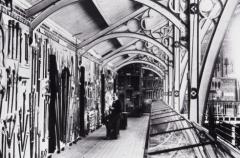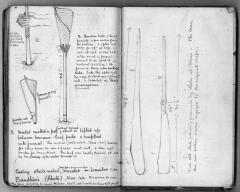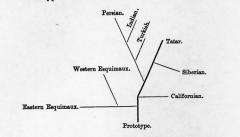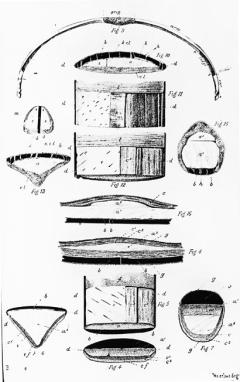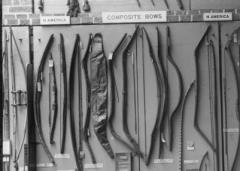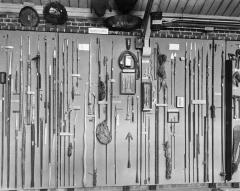ENGLAND: THE OTHER WITHIN
Analysing the English Collections at the Pitt Rivers Museum
Balfour, Pitt Rivers and the study of weapons
Frances Larson
This section of the website, which was written during the Relational Museum research project at the Pitt Rivers Museum (2002-2006), discusses the early history of weapon collections at the Pitt Rivers Museum. Both General Pitt Rivers and Henry Balfour were fascinated by weapons, and they each collected many thousands of spears, bows and arrows, guns, shields, knives and other weaponry. This paper briefly introduces Pitt Rivers’ work on the history of warfare, and then focuses on two of Henry Balfour’s early publications on bows and arrows. Balfour, who was influenced by Pitt Rivers’, approached his study of weapons slightly differently, which caused some tensions between the young curator in Oxford and the founder of the collection.
Pitt Rivers and the history of warfare
The museum that General Pitt Rivers gave to Oxford University in the early 1880s began as a small collection of weapons thirty years earlier. Pitt Rivers’ initial interest in the development of firearms during the 1850s grew into a fascination with weaponry from other cultures, particularly societies, past and present, whose material culture seemed to suggest the beginnings of human society. As his interest in the origin of weapons grew, he began acquiring simple stone implements, many of which could have been used as weapons or tools, depending on the context. Although his studies broadened out to encompass a whole range of material arts and industries, tools and weapons continued to dominate Pitt Rivers’ collection, making up around 46% of the objects he donated to Oxford.
The Museum’s collections are still dominated by tools and weapons today, and have been throughout its existence. Although the rate of acquisition has slowed since the 1950s, remarkably, tools and weapons still account for 46% of the Museum’s entire collections. Pitt Rivers’ intellectual influence appears to have lived on in this regard. Tools and weapons figured prominently Henry Balfour’s collection: they account for 42% of his own contribution to the Museum, and Balfour’s influence over the first fifty years of the Museum’s existence had an enormous impact on the way the collections took shape. Balfour, following in Pitt Rivers’ footsteps, may have had a greater influence on the growing collections of tools and weapons at Oxford than the General did.
Pitt Rivers’s interest in weapons lived on through Henry Balfour, and to some extent the growth of the Museum’s collections of weapons and stone tools is a testament to Balfour’s admiration for Pitt Rivers’ legacy. However, it is also a result of the broader academic perception of ‘savage’ society at the time, as bellicose, primitive and collectable, a perception which fuelled the earliest years of professional anthropology. In the context of the late Victorian obsession with human progress and origins, weapons and stone tools encapsulated everything that a good savage was supposed to be. Pitt Rivers’ own military career and his early interest in collecting weapons, coupled with the impact evolutionary theory had on his thinking during the 1860s, led him to the conclusion that belligerence was a basic human impulse, and furthermore, it was the impulse that underpinned the origins of all cultural life.
‘[We] need not, I think, be long in coming to the conclusion, that the school of our first parent must be sought for in his struggles for mastery in the brute creation, and that, consequently, his first lessons must have been directed to attaining proficiency in the art of war…Nor indeed shall we fail to find abundant evidence that there is hardly a single branch of human industry which may not reasonably be attributed to the same source.’ (Lane-Fox 1867: 54)
Pitt Rivers identified three universal human instincts: alimentiveness (the desire to seek food), amativeness (the desire to reproduce) and combativeness. The last of these was, according to Pitt Rivers, another means by which man progressed according to the laws of natural selection. Just as there could be no life without food or procreation, so there was ‘no evidence in nature for a state of society in which war will cease’ (ibid: 56). Pitt Rivers traced the origins of the warring instinct ‘back’ to the animal kingdom, arguing that primitive man had learnt lessons from nature’s solutions to the problems of defensive and offensive weapons, so that the origin of human armour could be traced to animal hides, scales and shells, and the origin of spears and piercing weapons was found in the horns of the rhinoceros, boar and walrus.
The social and moral implications of this philosophy resound in the names that were used during the nineteenth century for societies without a government infrastructure: ‘barbarous’, ‘savage’, ‘brute’ and so on. These ‘simple’ societies were deemed to be the most primitive and, therefore, the most warlike. In this context, Pitt Rivers’ professional expertise in the technology of war seemed to lend itself to the study of all human cultures. The artefacts of war provided the perfect data for studying the gradual ‘evolution’ of human culture, from the most simple to the most complex. The technology of war linked – and yet distinguished – all human beings throughout the world. If Pitt Rivers could demonstrate the thousands of tiny modifications that had accrued in human arts and industries since the dawn of human culture, he could simultaneously uphold the evolutionists’ claims that humans were animals too, by showing an unbroken continuity of cultural ‘progress’, and provide some reassurance that his own cultural experience was at the furthest extreme from the ‘original’, ‘animal’ state that so fascinated him. The need for technologies of war might be universal, but the differences between a roughly formed stone implement and the complicated mechanics of a single-shot rifle were plain to see.
Despite the fact that Pitt Rivers had acquired all sorts of artefacts, he became known for his collection of weapons. E.B. Tylor, for example, referred to the General’s collection as a ‘Museum of Weapons’ (Tylor 1881: 458, see also 1884: 549).
Balfour’s work on arrows from the Solomon Islands
Henry Balfour began working at the Pitt Rivers Museum in the autumn of 1885, and his first paper, which he read before the Anthropological Institute in January 1888, was called, ‘On the Evolution of a Characteristic Pattern on the Shafts of Arrows from the Solomon Islands’. Balfour’s paper owed intellectual debts to Pitt Rivers. Balfour took a group of arrows from the Solomon Islands that he had been working on at the Museum and arranged them according to the designs incised around the arrow-shaft, from the most natural, where the joints of the reed shaft were left untouched, to the most intricately carved. In classifying the arrows into a series based on the gradual modification of forms – resulting in a picture of continuous development from the most simple to the most complex – Balfour was emulating Pitt Rivers’ typological approach.
Although he tended to skirt around the subject, Pitt Rivers had argued that ‘under like conditions like results have been produced’ (1868: 89). Balfour, accordingly, tried to extend his study out to encompass reed-shaft arrows from around the world, but, like Pitt Rivers, he found it difficult to maintain this strict system of classification when he tried to apply it to a wider selection of arrows:
‘Although in most of these regions [where arrows with reed-shafts occur] some trace of ornamental adaptation of this pairing of the joint obtains, in none have I found the design, developed in this way, so highly modified into a purely conventional pattern as in the Solomon Island series.’ (1888: 331)
Balfour’s paper, which began as a tight analysis of form focused on a limited cultural area, became a brief account of spears and arrows around the world. Despite his obvious debt to Pitt Rivers in this early publication, the tone and analytical emphasis of Balfour’s work is different. Balfour cited Pitt Rivers’ work on a series of New Ireland paddles, published thirteen years earlier in the Proceedings of the Royal Institution, as his inspiration (Pitt Rivers 1875), but Pitt Rivers’ classification was based on the surface design of the paddles. Pitt Rivers ordered objects primarily according to the way they looked: how straight or curved a boomerang was, how large or small a club-head was, whether the human-like figure on a paddle showed both arms and legs, or only those on one side. Although he also considered the weight or thickness of an implement – Australians, for example, would have realized that a boomerang with a flat underside would rise through the air more effectively – Pitt Rivers generally relied on the outline form of an object or its surface decoration, rather than its three-dimensional qualities, when piecing together his classifications.
This is evident in the illustrations that accompanied his publications, which show little attempt to convey the solidity of the artefacts and generally reduce them to two-dimensional, flat figures. The figures used to illustrate the New Ireland paddles are a case in point. Although they provide an extremely clear depiction of the respective designs, it is impossible to work out how those designs relate to the object on which they are placed. The accompanying text is simply a descriptive list, and adds little to the illustration: ‘In the third figure the man is represented sitting sideways, simply by lopping off an arm and a leg on one side. In the fourth figure the legs have disappeared. In the fifth figure the whole body has disappeared…’ (Pitt Rivers 1906 (1875): 41).
Balfour, in contrast, showed a keen appreciation of the physicality of the objects he described. Indeed, his classification of the Solomon Island arrows was based on the idea that the rough natural joint in the reed shaft would have proved uncomfortable during use, as it passed over the hand, and the resulting friction between hand and arrow may have even interfered with the arrow’s flight. Paring down the joint helped, and, Balfour hypothesized, the incised ornamentation around the joint developed as the Islanders found ways to stop strips of reed peeling away as a result. Balfour brought a sense of the material qualities of objects, and the practicalities of using them, into his analysis. He had undertaken a practical ‘trial’ which seemed to prove that discharging the unadulterated arrows was ‘inconvenient’ and the roughness was unpleasant (Balfour 1889: 30), but in this he was not unusual, because many ethnographers used the objects they studied at this time, including Pitt Rivers. The difference came, not so much in his research practices, but in the emphasis of his analytical argument.
Balfour’s paper is thick with detailed descriptions in a way that Pitt Rivers’ arguments were not. Balfour wrote of the Solomon Islands arrows:
‘The fibrous substance of the stem appears as the silicious exterior is removed in the process [of paring down the joint]. Now, from the fibrous nature of the substance of the reed, there would be a tendency for narrow strips to peel away along the length of the shaft when started by an incision, in the attempt to remove small shavings. To prevent this peeling extending far, cross notches were cut…the peeled lines varying in length.’ (Balfour 1888: 329)
It is no coincidence that Balfour was a talented artist, and his drawings of the reed joints on these arrows are beautiful, light, three-dimensional depictions, in contrast to the solid, diagrammatic figures used by Pitt Rivers. Both styles had their advantages, but the contrast seems to betray a difference in analytical emphasis.
Balfour’s work on the Composite Bow and Pitt Rivers’ response
The differences between Balfour’s approach and that of Pitt Rivers were even more apparent in Balfour’s next paper, read before the Anthropological Institute in June 1889 and published the following year, ‘On the Structure and Affinities of the Composite Bow’ (Balfour 1890). This paper was more ambitious than the one he had written on arrows, but in essence it followed the same format. Balfour aimed to ‘investigate further’ a subject that had been originally explored by Pitt Rivers (it was Pitt Rivers who had distinguished between ‘plain bows’, made out of a single piece of wood or horn, and ‘composite bows’, constructed out of numerous parts). Although Balfour was interested in gradual modifications in form, this time he considered the entire construction and design of the bows, rather than a single aspect of their surface decoration. Again, as a result of this analysis he reflected on the probable development of these weapons through time, but now he also considered their development through space in much more detail, from the composite bows used by Inuit people to the more complicated forms used in Asian countries.
Balfour’s emphasis on the physical properties of the individual objects reached new heights in this paper. Indeed, it was on this point that he differentiated his work from other studies: ‘Apart from the writings of General Pitt Rivers very little appears to have been written to describe the complex structural peculiarities of the higher types of the composite bow, and that little, so far as I have been able to ascertain, is for the most part extremely vague and superficial’ (1890: 220, original emphasis). Balfour’s paper addressed the structural peculiarities of the composite bow to a degree that had never been matched by Pitt Rivers, and has probably never been matched before or since. Balfour quite literally took bows to pieces, dissecting them to try and understand exactly how they had been made, and working out which materials had been used and how they had been stuck together. He produced a series of longitudinal and transverse sections through the bows as a result, which he drew and labelled carefully (the drawings were published with his paper and were later shown next to the bows on display in the Museum).
Balfour wrote a series of comprehensive descriptions detailing the construction of the main ‘types’ of bow: he explained which bows had a grip made of wood and whether this was covered with birch bark, cork, leather or shark skin; in some, there was a thick layer of horn over the bow’s ‘belly’ and he described whether it was edged with bone strips or horn strips or cane; he described whether the sinews were plaited, or twisted together into a double or a single rope, and when they were scored with deep scratches giving a rough surface and a firm hold; he specified when the sinews were bound transversely and when they were cross-laced, and whether any kind of glue was used; he noted whether the entire structure was backed with coats of bark and lacquer or paint, and so on. Balfour sought to analyse the materiality of the bows in a new, more rigorous, scientific way.
Balfour also suggested – albeit implicitly – a different theory for the geographical development and distribution of the composite bow. He did not stress this aspect of his paper, preferring to focus on the structural design of the individual bows he had studied in turn, but he started his analysis with the simplest composite bows, from Arctic North America, before discussing those found on the Northwest Coast of America, and finally considering the ‘higher’, more structurally complex bows found in Asia. Pitt Rivers had argued that the composite bow had originated somewhere in Central or Northern Asia, where the lack of suitable wood necessitated making a bow from a range of different materials. From here, Pitt Rivers thought, this type of bow had spread through Northeast Asia, across Behring Strait, and then branched into two, with one strand spreading down the west coast of North America to California, and the other along north coast and islands over to Greenland: ‘Throughout this region we have the clearest evidence of connexion and gradual variation…’ (Pitt Rivers 1877: 49). Pitt Rivers pictured an eastward development, from Asia to America, with a steady ‘degeneration’ of form from complex bows to simple ones. Although Balfour supported Pitt Rivers’ argument for an origin in Central Asia, he only mentioned this briefly and the organization of his paper implied a reversal of Pitt Rivers’ theory of distribution, from the simple bows of Arctic North America to the complicated designs of Asia. For Pitt Rivers, the composite bow was an inferior version of the plain bow that must have been constructed out of necessity because of a lack of suitable materials, whereas Balfour’s paper inferred a history of technology that had progressed gradually from simple forms to more complicated ones.
Balfour was absent when his paper on composite bows was read at a meeting of the Anthropological Institute in 1889, and it was read by the Secretary, Frederick Rudler. However, Pitt Rivers was there to hear it, and he spoke in response afterwards and later supplied a lengthy discussion which was appended to Balfour’s paper for publication in the Journal. Although Balfour had not dwelt on the diffusionist arguments presented by Pitt Rivers – ‘my purpose being merely to describe the prominent types which seem to indicate the various epochs in the history of this weapon’ (1890: 222) – Pitt Rivers tackled this issue more directly in his discussion. His problem lay in deciding whether the simpler, Arctic American bows were degenerative forms of more complicated Asian bows, or whether they were simpler forerunners to the Asian weapons.
Pitt Rivers believed that the root of this problem lay in the historical relationship between the composite bow and the plain bow: was the composite bow an inferior version of the plain bow, made out of necessity in the absence of suitable materials, or was it an improvement on the simpler form? If the composite bow was found to be better than the plain bow, then the simpler composite bows could be seen as degenerative versions of higher types, and the historical distribution would have spread from Asia to America. If the most perfect composite bow was still inferior to the plain bow, then the simpler composite bows may well have been earlier, inferior forms, which had spread and improved from America to Asia.
What is interesting about Pitt Rivers’ response is that he stressed the importance of studying the bow as a functioning implement, as a tool of war. He believed the key to its history lay in its effectiveness as a weapon. He argued that Balfour’s work on their construction should be complemented by an investigation of how the weapons compared in use: ‘he [Balfour] has not said anything about the advantages which the different changes and additions were destined to achieve’ (Pitt Rivers 1890: 248). Pitt Rivers drew attention to his own professional skills: ‘In the early part of my professional career as Chief Inspector of Musketry, I had considerable experience in the methods of testing the range and accuracy of missile weapons, and I am well aware of how much care would be required for such an investigation’ (Pitt Rivers 1890: 248-9). Balfour’s dissections and diagrams had conveyed the physicality of the objects in a static, scientific sense, but, beyond the occasional passing reference, he had neglected to describe how they responded when employed as weapons. Pitt Rivers argued that although the question of the diffusion of the composite bow was unsolved, ‘the bow cannot be studied apart from its performances’ (1890: 250).
Pitt Rivers concluded that Balfour had added little to the debate regarding the diffusion of the composite bow, beyond confirming his own views on the matter (since Balfour had acknowledged Pitt Rivers’ theories of diffusion, even if the overall structure of his article suggested a reversal of that theory) and adding a significant amount of detail on the construction of the bows. He finished by reminding Balfour that Museum curators were blessed with an ‘almost unlimited’ range of material to work with – ‘in a museum so designed and arranged, no halting place is possible’ – and added, ‘I trust he [Balfour] will be encouraged to take up hereafter an original subject of his own’ (1890: 250). Weaponry was his specialist area and Balfour, who was still in his twenties, needed to find his own area of expertise.
Balfour claimed that he had not intended to write a paper on Pitt Rivers’ series of bows. It had begun as a distinctive study discussing ‘the ‘complex structure of the higher types’ by means of dissection’, prompted by the fact that E.B. Tylor had given him a fine, old bow from Persia that had already been broken, leaving Balfour free to cut it up further (ibid; Balfour 1890: 221). But as his research progressed he had found it necessary to broaden out his comparison and consider a range of different composite bows, so found himself following more closely Pitt Rivers’ previous work on the subject. He had chosen an area closely associated with Pitt Rivers, and what had begun as a complimentary piece of research was eventually perceived by Pitt Rivers as encroaching on his own specialist area.
The tensions between Pitt Rivers and Balfour over Balfour’s ‘Composite Bow’ paper in the 1890s resulted from the different ways in which objects could be categorized: as functioning tools, as examples of artistic ingenuity, as objects that had been engineered using the materials and technologies that were available at the time. These different perspectives meant that there could be struggles over the best way to group artefacts together. Different criteria could lead to different classifications, and therefore, different visions of the past.
Balfour’s collection of weapons and the weaponry collections at the Pitt Rivers Museum
Balfour’s own collection of weaponry started relatively tentatively: he had only contributed 241 weapons to the collections at the Pitt Rivers Museum by 1900. These early donations included 163 arrows, the majority of them English. In the context of the thousands of weapons Balfour was to present to the Museum over the course of his lifetime, these figures imply a cautious interest in the subject following his tense exchange with Pitt Rivers over the composite bows.
Meanwhile, overall accessions of weapons at the Pitt Rivers Museum – that is, definite weapons that could not be described as tools – remained consistently high throughout the pre-Second World War period. Both private collectors and institutions gave weapons to the Museum, among them the Ashmolean Museum (1880s), the Royal Botanic Gardens at Kew (1890s), the London Missionary Society (1910s), the British Museum (1890s-1920s), the Royal Geographical Society (1920s), the Indian Institute (1930s), and the Wellcome Historical Medical Museum (1940s).
It is hard – if not impossible – to say why so many tools and weapons were accessioned into the collections between 1885 and 1945, and how far this was due to the strong association that continued to be made between General Pitt Rivers’ work and the Museum he founded at Oxford. It is likely to be a combination of Pitt Rivers’ personal reputation, Balfour’s ongoing influence, and, particularly during the first half of the sixty-year period, the perception that ethnographic subjects were, by definition, likely to be warlike and that weapons were particularly ‘ethnographic’ objects. A significant number of weapons were bought for the collections, and Balfour must have been responsible for these purchases. Of course, Balfour’s interests will be partly reflected in the donations too, since his ability to canvas donations must be taken into account. For instance, Robert Francis Wilkins, Henry Balfour’s father-in-law, is the source for 767 weapons, 473 of which were accessioned in the 1900s. Weapons account for around 60% of Wilkins’ collection at the Pitt Rivers Museum.
The large number of weapons in the collections at the Pitt Rivers Museum hint at a worldview in which weapons were accepted as markers of technological – and therefore cultural – prowess. The design of a weapon was thought to reflect how efficiently a group of people could hunt and kill, whether for food, for defence, or for social status. Today, weapons still attract interest, and perhaps this is because they are so personal and so powerful, making people into killers. Weapons embody, and facilitate, fundamental human survival instincts. And, since they provide food and safety, they are also common to many human beings in the world. For scholars like Pitt Rivers and Balfour, this not only made them ideal for comparing cultural solutions to similar technological problems, it meant that they appealed to the late Victorian concern for human origins. Weapons invoked fear and respect for the ‘primitive Other’ in equal measure, but those who collected weapons did so in the reassuring knowledge that their own society’s arsenal was much more efficient and ‘civilised’.
Further Reading
Balfour, H., ‘On the Evolution of a Characteristic Pattern on the Shafts of Arrows from the Solomon Islands’, Journal of the Anthropological Institute of Great Britain and Ireland, 17 (1888), 328-332.
Balfour, H., ‘On the Structure and Affinities of the Composite Bow’, Journal of the Anthropological Institute of Great Britain and Ireland, 19 (1889c), 220-250.
Lane-Fox, A.H. 1867 ‘Primitive Warfare I’. Reprinted in J.L. Myers (ed.), The Evolution of Culture and other essays (Oxford: Clarendon Press, 1906), 20-44.
Lane-Fox, A.H. 1868 ‘Primitive Warfare II’. Reprinted in J.L. Myers (ed.), The Evolution of Culture and other essays (Oxford: Clarendon Press, 1906), 20-44.
Lane Fox, A. H., ‘On the Evolution of Culture’ originally in Proceedings of the Royal Institution VII, (1875), 496-520. Reprinted in J.L. Myers (ed.), The Evolution of Culture and other essays (Oxford: Clarendon Press, 1906), 20-44.
Tylor, E.B. 1881 ‘Presidential Address to the Anthropological Institute’ in Journal of the Anthropological Institute of Great Britain and Ireland 10: 440-458
Tylor, E.B. 1884 ‘How the Problems of American Anthropology Present Themselves to the English Mind’ in Science 4 (98): 545-551
